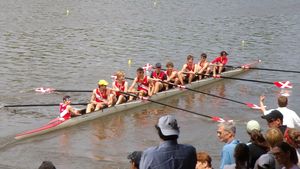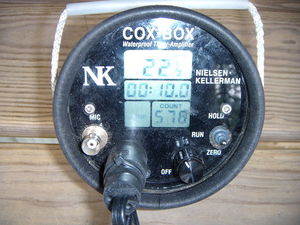Electronics in the sport of Rowing
The sport of rowing uses many electronic devices, especially for timing the races (the margin of victory may be in thousands of a second) and for measuring the numbers of strokes per minute, and -- on land -- to measure the effort expended by rowers using an excercise machine called an ergometer ("erg" for short). Aboard the boat (called a "shell") a device called a CoxBox controls the shell's loudspeaker system, as well as measures the number of strokes per minute (the rating), total strokes taken, and also provides a timer to assist the coxswain (who steers the boat) in conducting the drills or timing a race.
The CoxBox was invented by Richard Kellerman and Paul Nielsen who later formed their own company, NK, to manufacture them. Coach Ted Nash, who was then coaching at the University of Pennsylvania, encouraged its development. Oral History with Richard Kellerman and Alix Kocher on the history of the CoxBox
The timing of rowing races is done in a number of ways depending on the electronics available at the race venue. The simplest way is for a race official who follows the boats in the race in a launch, to start a stopwatch when the starter says go, and to click a button to take the splits from watching a flag on shore at the finish line. The flagger signals when the bow of each boat crosses the finish line by alternatively lowering and raising the flag.
A more precise method is to use radio, where a timer at the finish line listens by radio for the starter's command to start the stopwatch, and then takes the finish splits by clicking the split button as the bow of each shell crosses the finish line. This helps to eliminate some of the imprecision caused by human reaction time. Sometimes the finishes are so close that the flagger cannot raise and lower the flag quickly enough to be perfectly accurate.
When timing head races, which are long (typically between three and five-plus kilometers) races where a series of boats start in a moving start roughly fifteen seconds apart, and the places are determined by elapsed time, the clock is allowed to run continuously and the exact time each boat crosses the starting line is subtracted from the exact time that boat crosses the finish line to give the total time over the course. This way, as many as 1800 boats can be timed with the same clock in the course of a full day of racing.
Because finishes can be extremely close, video cameras are used at the finish line so that judges can consult them to determine the order of finish.

